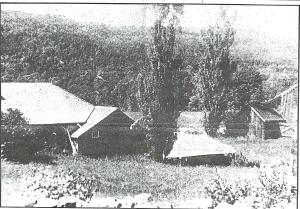MADISON – The farm sits at the end of a dirt road in the Silver Lake area of Madison. There is a small, unpretentious Cape Cod house situated in the middle of a hillside meadow facing Mount Chocorua with an el attached to a woodshed and a small barn, all dressed in weather-beaten clapboards. A small bronze plaque has been affixed to the dwelling, proclaiming that the house is on the National Register of Historic Places.
What’s significant about the house and grounds — known simply as Joy Farm — is that it was the summer residence of a man recognized throughout the world as one of America’s greatest poets — E. E. Cummings.
Undoubtedly Cummings would have mixed emotions about his home being designated a national historic place. A poet, artist, novelist and social satirist, Cummings was an intensely private man who savored his solitude and it was at Joy Farm and Silver Lake that he found that solitude which helped in the creation of many of his most famous works.
Born Oct. 14, 1894 and baptized Edward Estlin, young Cummings’ began visiting New Hampshire as an infant when his father, Dr. Edward Cummings, a Congregational minister, bought the farm in Silver Lake. It was called “Joy Farm” after its previous owner, Ephraim Joy, but as Cummings’ younger sister, Elizabeth, later wrote — “it earned the name on its own account.”
Dr. Cummings put in windows on the farmhouse from which Mount Chocorua could easily be seen, and an extension with a flat roof from which the sunset and stars could be seen.
It was on that flat rooftop that Estlin (the name he preferred to use) painted oil landscapes and watercolor sunsets. It was at Joy Farm that the Cummings children learned woods lore and were taught self-reliance when exploring the area or boating on the waters of Silver Lake, where once the Cummings children faced great peril.
In 1936, Dr. Cummings was killed when the car he was driving was struck by a train at the crossing in Ossipee during a blinding snowstorm. Joy Farm eventually became Estlin’s, and a small cottage on Silver Lake his sister’s. The young poet continued coming to New Hampshire each summer and it proved to figure greatly in his later works.
It was on a September day in 1962 that E. E. Cummings drove his old Ford down to the Silver Lake post office and dropped off the final draft of Adventures in Value, the book of photographs by Marion Morehouse , many of which were taken at Joy Farm, with text by E. E. Cummings. Later that afternoon, upon his return to Joy Farm, Cummings suffered a cerebral hemorrhage. He was rushed to Memorial Hospital where he died early the next morning. Marion continued coming to Joy Farm until her death in 1968, after which the farm was sold.
Joy Farm still sits remote and unpretentious, like its former owner who once expressed his feelings about the farm in a letter he wrote to Ruth Shackford prior to coming to Silver Lake for his summer visit. “Please thank Buddy for taking such wonderful care of Joy Farm. I guess he knows how much it means to us to feel the place we love best in the world is sound and safe!”
Excerpts from Northern Light front-page article about Joy Farm dated Tuesday, August 20, 1985, by Kevin Early.



Darrell Knox said:
I am originally from Carroll County, born in 1947 in the hospital where Estlin Cummings would die 15 years later.
While I spent many happy times in the home and company of my grandparents, George and Erma Nickerson, in Vhocorua village, it was only years after her death that I realized that the “Professor Cummings” that she often referenced as her employer (as his housekeeper) was the reclusive poet.
LikeLike